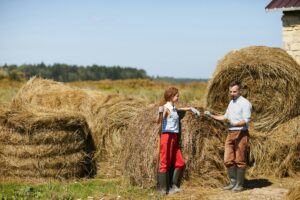Fields of the Future: Discovering Sustainable Farming in the Countryside


Sustainable farming has become an essential part of conversations about food, climate, and community. Families who explore the countryside often discover that farms are more than fields—they are living examples of how people can work in harmony with the land. Farmers who use sustainable practices focus on protecting soil, water, and biodiversity while still providing food for local communities. This balance ensures that agriculture can continue to thrive for generations to come.
Moreover, sustainable farming demonstrates that progress does not always mean expansion or industrial growth. Instead, it often means returning to practices that respect natural rhythms. By visiting farms that prioritize conservation, families learn that every choice—from how crops are grown to how animals are raised—affects the environment. These visits provide valuable lessons about responsibility and encourage children to see farming not just as labor, but as a thoughtful and caring relationship with the earth.
Conserving Soil and Water
Healthy soil is the foundation of sustainable farming, and many farmers dedicate their efforts to protecting it. Through methods such as crop rotation and cover planting, they prevent erosion while enriching the soil naturally. Families who walk through these farms can see how careful planning transforms the ground into a living system that supports growth year after year. Parents often explain to children that strong soil leads to healthier food, creating a direct connection between conservation and their own meals.
Water conservation plays an equally important role in farming practices. Farmers use irrigation systems designed to minimize waste, ensuring that crops receive only the water they need. Families visiting the countryside notice how these methods not only protect natural resources but also teach responsibility. Parents can highlight how water, often taken for granted, requires careful stewardship. By observing these efforts firsthand, families gain a greater respect for the resources that sustain daily life.
Protecting Biodiversity on Farms
Sustainable farms often encourage biodiversity by planting a variety of crops and maintaining natural habitats. Families who explore these farms notice the presence of birds, insects, and other wildlife living alongside cultivated plants. Parents explain to children how each species plays a role in keeping the ecosystem balanced. Instead of seeing pests as enemies, farmers often work with natural predators to manage them, showing that cooperation with nature is more effective than control.
This biodiversity also provides resilience. Families learn that farms with a variety of crops are better prepared to withstand disease, weather shifts, and market changes. Parents often connect this lesson to the idea of diversity in human communities, showing children how variety creates strength. In this way, sustainable farming not only protects the environment but also offers families valuable insights into resilience and adaptation.
Embracing Renewable Energy
Energy use is another area where sustainable farming makes a difference. Many countryside farms now use solar panels or wind turbines to power their operations. Families who see these technologies in action understand that agriculture can adapt to modern needs without harming the environment. Parents often point out how renewable energy reduces reliance on fossil fuels, reinforcing the importance of innovation.
At the same time, these energy solutions demonstrate how farms can remain self-sufficient. Families discover that renewable systems allow farmers to manage costs and reduce environmental impact. Children, in particular, are inspired by the sight of solar panels glinting in the sun or turbines turning with the wind. These images connect farming to the future, showing that conservation and technology can work hand in hand.
Strengthening Local Communities
Sustainable farming not only benefits the environment but also strengthens local communities. Families who purchase food directly from these farms contribute to local economies while enjoying fresh, healthy produce. Parents explain to children how supporting local farmers ensures that money stays within the community, building stronger connections between neighbors. These relationships remind families that farming is not only about crops but also about people.
Furthermore, many sustainable farms host events, workshops, and markets that bring communities together. Families attending these gatherings learn about farming while also enjoying the sense of belonging that comes from shared experiences. Parents see how children benefit from knowing the people who grow their food, fostering gratitude and respect. By participating, families become part of a cycle that values both conservation and community well-being.
Teaching the Next Generation
Exploring sustainable farming practices provides children with lessons that extend far beyond the countryside. Parents who guide their families through these experiences teach values of responsibility, respect, and care. Watching farmers work with the land shows children that progress requires patience and dedication. These lessons often stay with them, shaping how they approach the environment in the future.
In addition, hands-on experiences make these lessons more meaningful. Families who pick fruit, feed animals, or plant seeds gain a deeper understanding of how food reaches their tables. Parents use these opportunities to connect everyday meals to the land and the people who sustain it. This tangible connection encourages children to make thoughtful choices as they grow, ensuring that conservation remains a part of their values.
Creating Lasting Change Through Awareness
The impact of sustainable farming extends beyond the fields themselves. Families who learn about these practices often return home with new perspectives and habits. Parents may choose to buy more local produce, reduce waste, or start gardens of their own. Children, inspired by what they have seen, may ask more questions about food and the environment. These small steps build a culture of awareness that supports broader change.
Ultimately, sustainable farming shows that conservation is not a distant concept but a daily practice. Families who explore these farms recognize the importance of aligning actions with values. By supporting farmers who prioritize the health of the land, they help shape a future where food and nature thrive together. These experiences prove that every visit to the countryside can be more than an outing—it can be a step toward lasting change.
